 If Karen Green wasn’t a rock star comics librarian before last night’s opening gala, she is now!
If Karen Green wasn’t a rock star comics librarian before last night’s opening gala, she is now!
So: the gist:
A few years ago, 2005 to be exact, the Ancient & Medieval History and Religion Librarian at Columbia University noticed a need for graphic novels to support the faculty and curriculum of the University. She began to systematically meet the needs of her patrons, while also selecting texts for the general collection. (She says the collection started with 3 volumes.)
Then, in 2011, Chris Claremont donated his archives to the University.
This was followed by gifts from:
…among others.
But… Columbia has been in existence since 1754. What else might exist buried deep in the archives? In the rare books collection? Elsewhere in the University?
Well, quite a bit!
This exhibit collects an amazing assortment of items… Lots of original art, rare books, correspondence… and ephemera as well. (Yes, you not only see Wendy Pini’s Red Sonja costume, but her meticulous sketches and planning!)
Some highlights:
- correspondence from Stan Lee to Denis Kitchen
- a comics script from Jerry Robinson
- original editorial cartoons from the Pulitzer Prize committee
- the sketches and final art from the Al Jaffee fold-in Batman variant
- the original art from Wendy Pini’s appearance in Elfquest (wow… the screens!)
- Chris Claremont’s notebooks
- The first page of the script to “Days of Future Past” (which includes some backstory I never considered before…)
- an entire display of “proto comics”, including Ward, Töpffer, and Busch
- William Moulton Marston’s contract for when he was a professor at Columbia
- comics produced by recent students and alumni (WOW)
The highlight for me? An “underground” comic (featured on the exhibition poster) from 1766, libeling a Kings College professor. The plot? He gets a female student drunk on spruce beer (yes, pine tree beer!), gets her pregnant, then pays for her abortion! The comic was confiscated, and used as evidence in the college’s disciplinary action against the students! You can read the sordid tale here. (SFW)
The exhibition opened Monday, with a reception last night. Here are some photos taken from the cheap seats, with a bit of commentary:
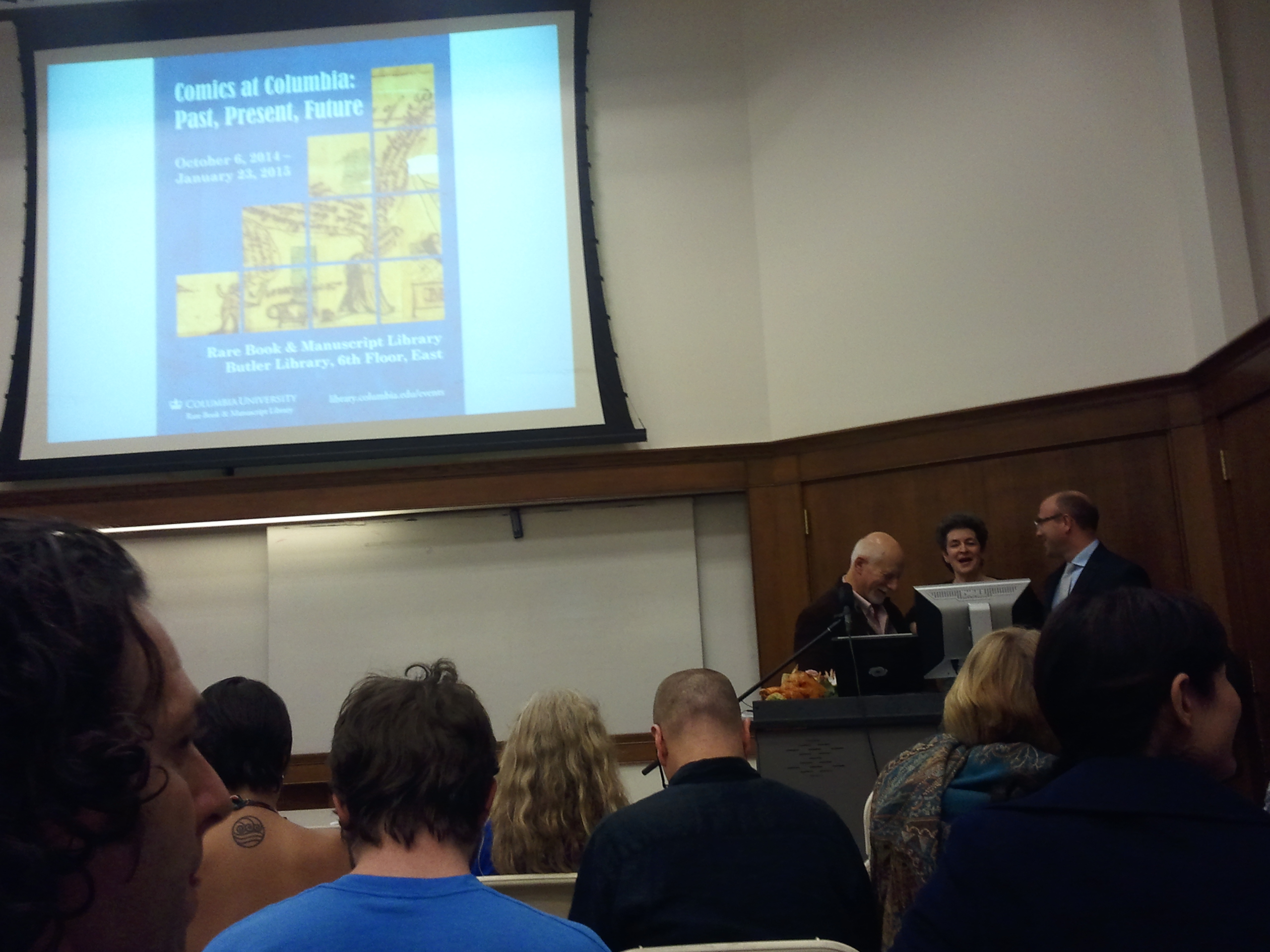 Chris Claremont, Karen Green, and Sean Quimby chat before festivities begin. Mr. Quimby, is “fresh off the bus” from Syracuse University, having just been appointed Director of the Rare Book & Manuscript Library. He gave his bona fides as a long-time comics fan, holding up a much-loved copy of the X-Men graphic album “God Loves, Man Kills”. (Syracuse itself has a decent archive of comics artists!)
Chris Claremont, Karen Green, and Sean Quimby chat before festivities begin. Mr. Quimby, is “fresh off the bus” from Syracuse University, having just been appointed Director of the Rare Book & Manuscript Library. He gave his bona fides as a long-time comics fan, holding up a much-loved copy of the X-Men graphic album “God Loves, Man Kills”. (Syracuse itself has a decent archive of comics artists!)
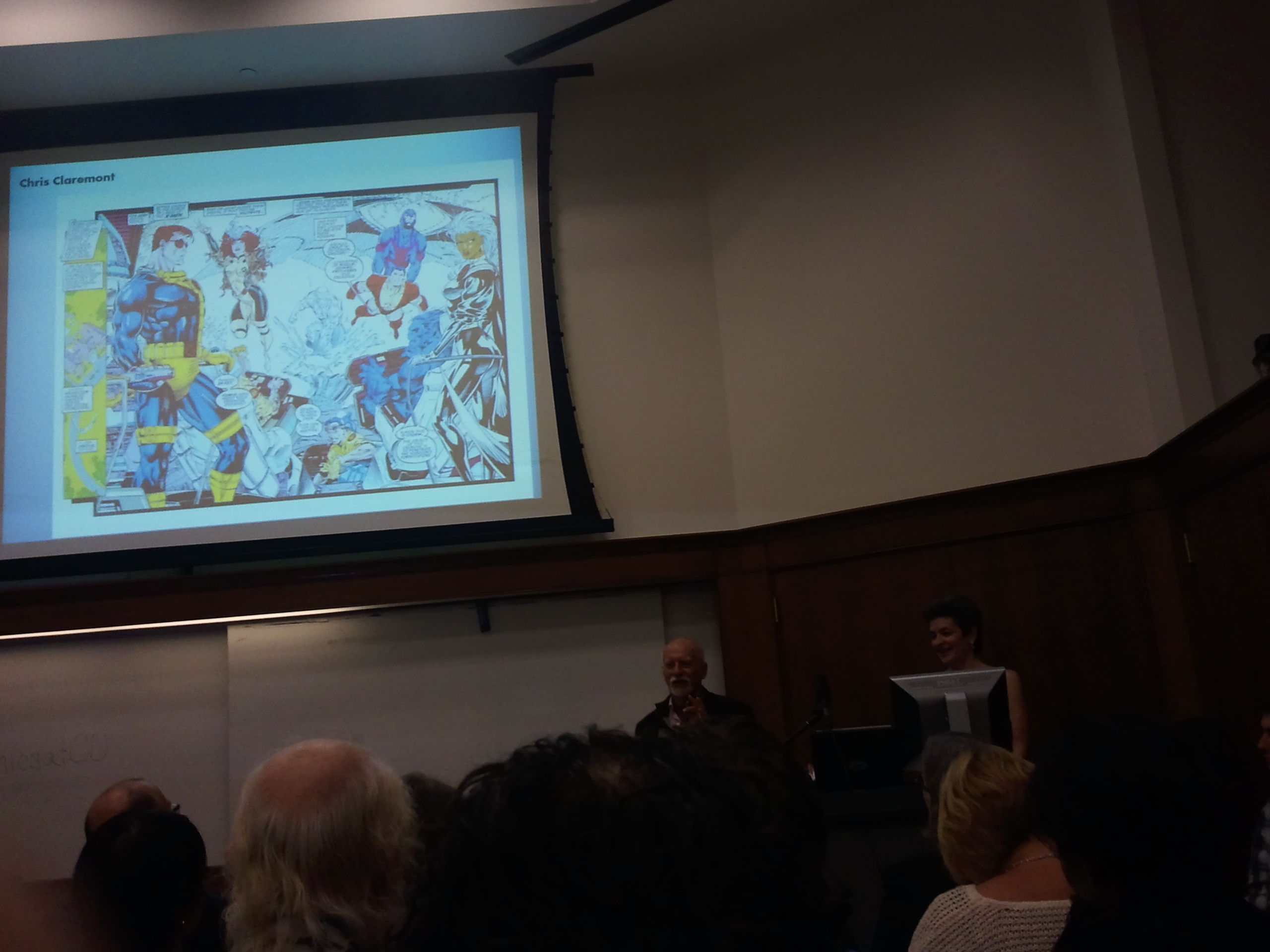 Chris Claremont gets the ball rolling, as each participant was given two slides and five minutes to speak.
Chris Claremont gets the ball rolling, as each participant was given two slides and five minutes to speak.
 Wendy and Richard Pini.
Wendy and Richard Pini.
 Andrea Tsurumi
Andrea Tsurumi
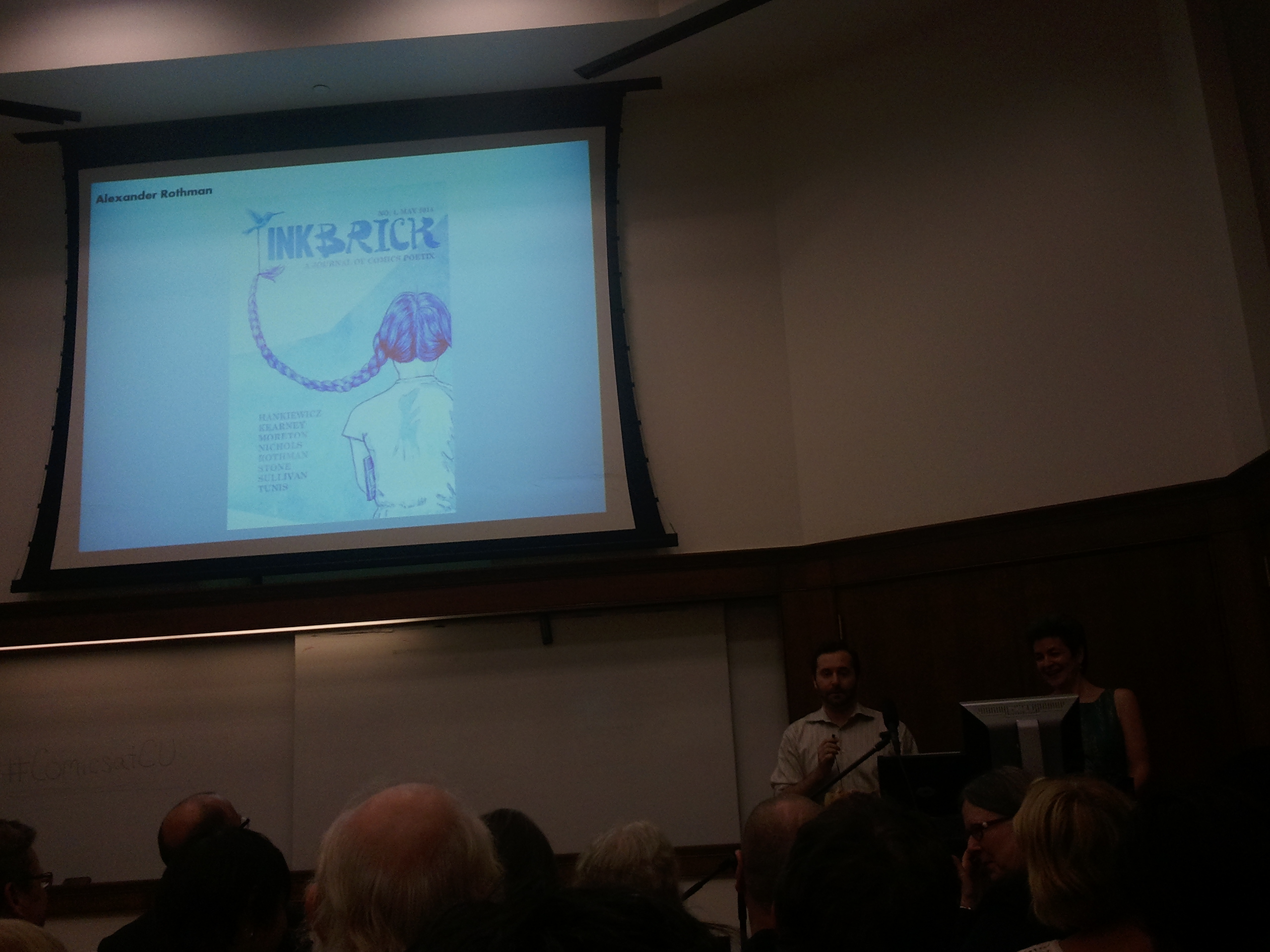 Alexander Rothman, creator of poetry comics
Alexander Rothman, creator of poetry comics
 Peter Kuper.
Peter Kuper.
 Gregory Benton.
Gregory Benton.
 Sophia Wiedeman
Sophia Wiedeman
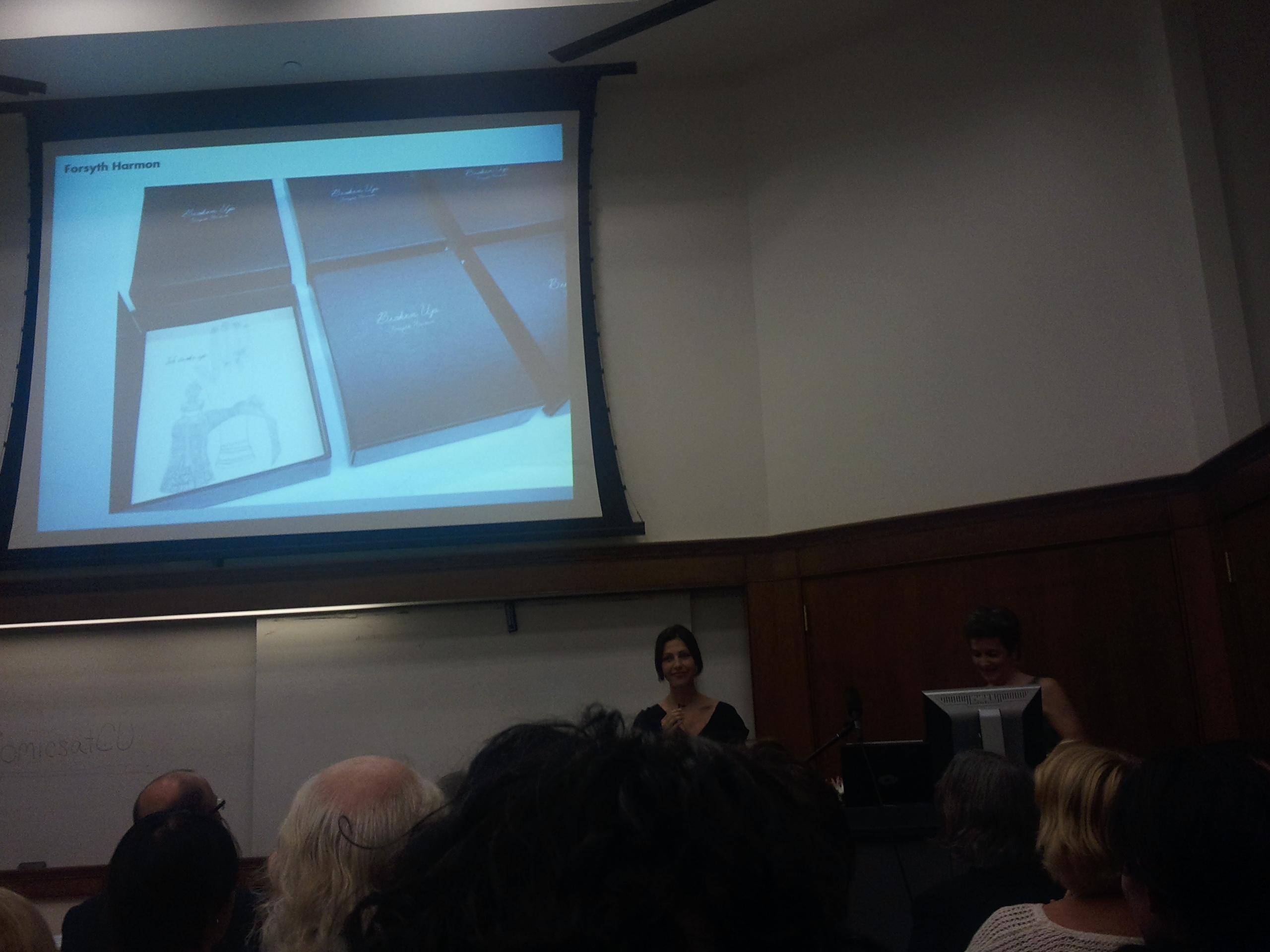 Forsyth Harmon. This is a boxed set of comics titled “Broken Up”, produced while she was a student at the Leroy Nieman Center for Print Studies at Columbia. As at other art schools, comics storytelling is cross-pollinating with art techniques at Columbia to produce new and interesting work!
Forsyth Harmon. This is a boxed set of comics titled “Broken Up”, produced while she was a student at the Leroy Nieman Center for Print Studies at Columbia. As at other art schools, comics storytelling is cross-pollinating with art techniques at Columbia to produce new and interesting work!
 Tom Motley. With Al Jaffee in the audience, Motley teased a double fold-in.
Tom Motley. With Al Jaffee in the audience, Motley teased a double fold-in.
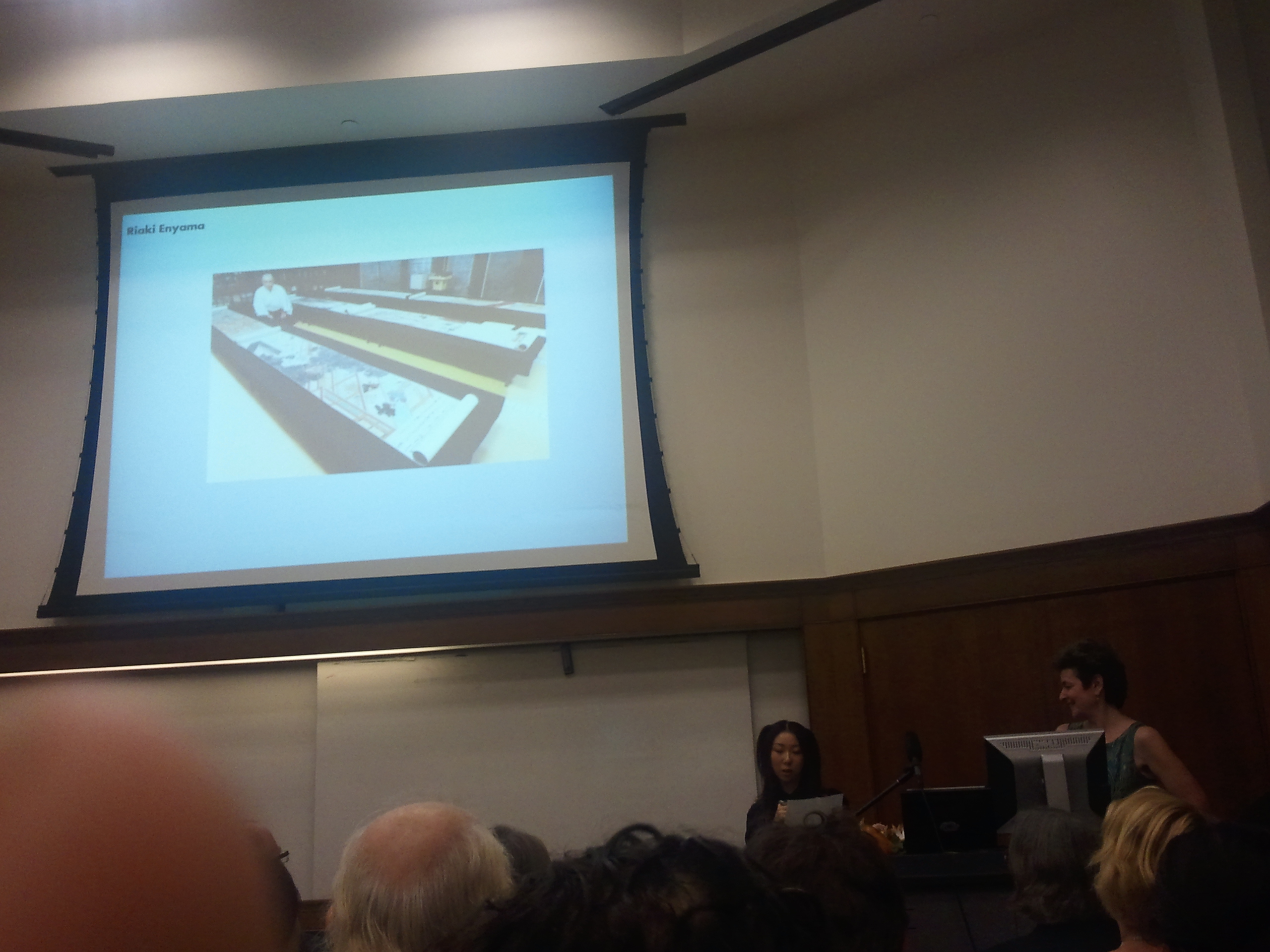 Riaki Enyama. Yes, that is her comic! Using the Japanese Emakimono storytelling scroll tradition, she chronicled her experience as a foreign student at Columbia.
Riaki Enyama. Yes, that is her comic! Using the Japanese Emakimono storytelling scroll tradition, she chronicled her experience as a foreign student at Columbia.
 Paul Levitz. The Jimmy Olsen of comics professionals!
Paul Levitz. The Jimmy Olsen of comics professionals!
 …and, a teaser from Karen Green, of a forgotten cartoonist: Amram Scheinfeld. What’s his story? Visit the exhibition and find out more!
…and, a teaser from Karen Green, of a forgotten cartoonist: Amram Scheinfeld. What’s his story? Visit the exhibition and find out more!
The event was recorded, and should be available online soon!
On January 23rd, Columbia University Library acquired a double-bill of Golden Age related comics materials, including the research materials Larry Tye compiled to write his Superman biography, The High Flying History of America’s Most Enduring Hero, and six 1940’s BATMAN scripts from the estate of Jerry Robinson. These add to the ongoing Rare Book and Manuscript Collection at Columbia under the steerage of Graphic Novels Librarian Karen Green, already including Chris Claremont’s 2011 X-Men archive donation, and the large ELFQUEST bequest announced in early March. Columbia University, and a standing room only audience on March 7th, decided it was time to celebrate the donation, with a panel and reception entitled “Comics at Columbia: The Golden Age”, fortuitously coinciding with Will Eisner Week throughout the country.
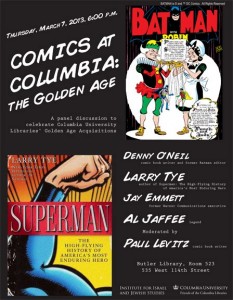
The panel was moderated by Paul Levitz, educator, writer, and former president of DC Comics, and included Jay Emmet, former Warner Communications executive responsible for some of the first licensing of DC characters into toys and games, Denny O’Neil, former BATMAN editor and comic book writer, Al Jaffee, whose ongoing career as an artist on MAD Magazine can only be described as legendary, and Larry Tye, journalist and biographer, most recently of Superman.
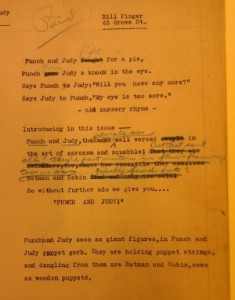
Levitz introduced panelists who he hoped would help express the Golden Age of comics as “lived and seen” and trace the impact of the Golden Age into later comics history and his synopses of their careers pointed out that Emmet’s licensing of toys and action figures changed American childhood experience, O’Neil’s career sparked an era of “social consciousness” in comics, Jafee’s work introduced the tradition of “wiseass” humor into American comics, and that Tye has brought a level of “serious” journalism and biography to comics history by carefully engaging with all those whose lives have impinged on Superman’s development.

Levit’z general question to his panelists, “Why comics?” sparked a great deal of discussion as each member delved into their own pasts and tried to convey how they became drawn into comics as a career and what part comics have played in their lives. Jaffee supplied the historical context for comics just before World War II. At the “height of the depression”, he said, with “non-existent job prospects and anti-Semitism engulfing Europe”, he and many of his contemporaries found that the “old, established advertizing agencies” in New York would simply reject applications from those with Jewish names. Comics, on the other hand, Jaffee explained, were dominated by Jewish editors, artists, and writers, and beginning to flourish at that time. Since “comic book people were receptive”, Jaffee said, he and his contemporaries “jumped into it”, particularly since it was a paying gig.

Emmet was born into the comics industry, as the nephew of a Warner board member, and he spoke quite frankly about the “greed” and money-driven aspects of the industry that he perceived growing up. He reflected on his own role in getting lifetime sum of money for Siegel and Schuster, but from a merchandiser’s perspective, Emmet still felt that the lack of pay for the creators of Superman was negligible. Emmet’s most personal story, however, included a “sad story”, as Jaffee described it, of having an entire “silo” of comic books and pop culture memorabilia destroyed by his spring-cleaning wife who didn’t realize their emotional value to him. Needless to say, as the nephew of a Warner executive, Emmet had “every issue” of Golden Age comics in the destroyed collection.
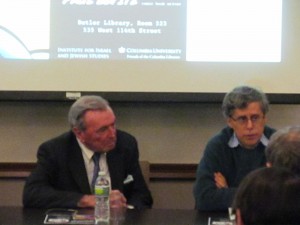
O’Neil spoke about his work post Golden Age, handling many of the same characters. Levitz asked O’Neil why he felt characters like Superman and Batman have lasted so long, and are still relevant today. O’Neil’s eloquent response conveyed a great deal about his philosophy of comics creation. You have to “keep the essence of characters intact but let them evolve”, he explained, a lesson he learned from Julie Schwartz. It’s essential, O’Neil feels, to “let the character reflect what’s outside the window” to remain relevant, and it’s “those allowed to evolve who are still with us”, he concluded.
Levitz humorously pointed out that of the panelists, most “wandered into comics before frontal lobes were fully developed for judgment”, leaving them little choice but to pursue the medium, however, Tye’s position as a biographer returning to comics as subject matter was unique. Tye explained that the question of why Americans embrace the heroes that they do led him to write his biography of the Man of Steel. He, too, however, had a childhood connection to Superman, and loved working on the book for two years, feeling “10 years old” again.
Levitz asked individual panelists some specific questions about their areas of expertise, and started off by asking Emmet to explain just how DC licensing came about. Emmet explained that licensing was a new idea when he was a young publicist, and that he wanted to do “what hadn’t been done before”. Remarkably, his uncle tried to dissuade him from giving up a cushy job to pursue licensing, but Emmet proved predictions wrong by making astonishing sales in his first year of work by simply visiting and personally pitching DC character licensing to every toy company in New York. When Jaffee was asked to talk about daily life working for MAD as a young man, as many cartoonists today will find relatable, he said he simply spent all his time cartooning. Jaffee discussed one unique aspect of working for MAD that stood in contrast to working on superhero comics, that he could “use many characters” and had “freedom” since MAD was a “voracious consumer of material”, but that the pressure could be intense to come up with new ideas since “I was only as good as the next idea I had”.
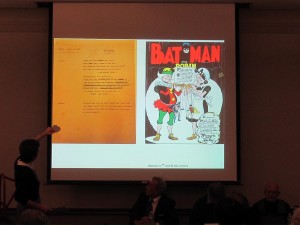
O’Neill was asked to discuss how he managed to write over a 1000 BATMAN stories and still keep material fresh for readers. He admitted that he personally has a “low attention span” and is “bored easily” so tried to bring that reality to his work. He “set the rules” for himself early on with a 5 page document that spread to 35 pages of notes by the end of his career reminding him of guidelines to keep Batman’s universe on track. But after that, as an editor, the key was to hire “good creative people” and give them a “sense that what they are doing is not trash”, and then know, as an editor, when to “step back”. Imbuing creators with a sense that their work has some particular value to readers and fans formed one of the themes for the evening’s discussion. O’Neil memorably commented that while writing comics for him was a “job” and he was cognizant of the need to provide for his family, the “first death” of Robin, decided upon by reader-response phone-calls to “vote” on whether Robin would “survive”, was a wake up call for him about the significance of his work. Ordering food in a deli one day soon after Robin’s “death”, the owner heard he edited BATMAN and declared to the other customers that this was the guy who had “killed Robin”. Previous to that moment, O’Neil said, he had felt he was working in a “backwater” of publishing, but afterwards felt that he was, in fact, a “custodian of post industrial folklore” with deep meaning for readers. It was a sobering moment for him that conveyed a sense of “uncomfortable responsibility” and “enormous privilege”.

Tye, certainly, agreed with the value of comics as an art form and the essential role of preserving and archiving documents, explaining that two kinds of records are particularly important in preserving comics history, the written documents, such as those produced in the Siegel and Schuster law cases that shed light on the Golden Age of comics, and secondly, the documentation of oral histories from those involved in the early days of comics who are still living. All the panelists agreed that they hope soon Columbia Library will also be able to archive audio recordings of oral histories, and many of the scholars and professionals attending the event in the audience confirmed that they have recordings that might be useful for such an archive. In the age of digital files and increasingly easy transfer between older formats and digital files, why not? Karen Green agreed that it was a possibility for Columbia to attempt to preserve these files in the future as part of their comics-related collection.
Levitz’ final assessments about the contribution of his panelists to pop culture included Emmet’s role in “creating American childhood” through licensing, Jaffee’s pioneering persona in encouraging us to “question everything” through his work on MAD, and the social realities that O’Neil introduced and maintained in comics, as well as Tye’s invaluable contribution to uncovering the history of Superman as a cultural phenomenon. It was certainly an evening spent celebrating comics, and in particular, a time to look back on the seminal periods in the development of comics that were directed in their development by true pioneers. What better way to dignify the impact of comics than to preserve their original documents for future study and appreciation? Collecting and archiving comics materials at Columbia has quickly moved from a new program to a steady stream of worthy additions, and the panel celebration suggested increasing momentum in preserving comics history at Columbia.
Hannah Means-Shannon writes and blogs about comics for TRIP CITY and Sequart.org and is currently working on books about Neil Gaiman and Alan Moore for Sequart. She is @hannahmenzies on Twitter and hannahmenziesblog on WordPress.
 Elizabeth grew up in Western New York State, studied art history at Skidmore College, and went on to earn a master’s degree in architecture from Columbia University. After working as a freelance architect and designer for, among others, The Municipal Art Society in New York, The Port Authority of NY & NJ, and various architectural firms, she got married, had a couple of kids, moved to Seattle, and had another kid. All the while, she kept herself sane by drawing pictures– mostly of other people’s kids– and did some fine art for a wonderful gallery in Seattle.
Elizabeth grew up in Western New York State, studied art history at Skidmore College, and went on to earn a master’s degree in architecture from Columbia University. After working as a freelance architect and designer for, among others, The Municipal Art Society in New York, The Port Authority of NY & NJ, and various architectural firms, she got married, had a couple of kids, moved to Seattle, and had another kid. All the while, she kept herself sane by drawing pictures– mostly of other people’s kids– and did some fine art for a wonderful gallery in Seattle.
Upon completion of her maternal duties, she discovered that all of her architect brain cells had died, so she turned to drawing and painting full-time–most recently FOR other people’s kids–and hasn’t looked back since. Her subject matter wanders over to the dark side sometimes, but generally she keeps things light, and always with an eye towards humor and whimsy. She is a fan of, to name but a few, John Tenniel, Beatrix Potter, John R Neill, James Thurber, Edward Gorey, and Lisbeth Zwerger–oh, and things that go bump in the night.

Elizabeth is a member of SCBWI International and SCBWI, Western Washington.
Here is Elizabeth explaining her process:
My illustration process varies, but generally begins with a lot of thinking about the overall “feel” of what I want to achieve. I tend to do a lot of research before I actually put pen or pencil to paper. I look at a lot of pictures, and I take a lot of pictures. When I’m satisfied, I start drawing the “pieces,” usually beginning with the main character(s), and then moving on to the setting and/or other characters. I then “assemble” them. I rarely plan anything out from start to finish. I tend to make decisions as I go along.

For example, for the IIllustrator’s Workshop at the SCBWI Western Washington conference few weeks ago, our “assignment” was to do an illustration of a classic Brothers Grimm fairy tale–with a “twist.” I chose Hansel & Gretel. I looked at a lot of old illustrations of Hansel & Gretel, pictures of woods and trees, and walked around my neighborhood looking at various trees. What popped into my head first was the notion of, “hungry children.” Hungry children aren’t always thin, I thought, and the house doesn’t necessarily need to be made of gingerbread and candy. So, as I usually do, I grabbed whatever paper or sketchbook that was on hand (in this case it was copier paper) and started sketching and came up with the characters. My work tends to be very character-driven, so that’s where I usually start.

I had an overall image of a classic setting, so I started to think about the next “piece”– the house. I wanted it to be tall and narrow, appearing as though Hansel & Gretel couldn’t fit through the door. I also wanted it to be a little ominous–it is, after all, a Grimm tale. I did an image search for tall narrow houses, and based it loosely on one I found.
 10 Comments on Illustrator Saturday – Elizabeth Rose Stanton, last added: 5/20/2012
10 Comments on Illustrator Saturday – Elizabeth Rose Stanton, last added: 5/20/2012

























 Elizabeth grew up in Western New York State, studied art history at Skidmore College, and went on to earn a master’s degree in architecture from Columbia University. After working as a freelance architect and designer for, among others, The Municipal Art Society in New York, The Port Authority of NY & NJ, and various architectural firms, she got married, had a couple of kids, moved to Seattle, and had another kid. All the while, she kept herself sane by drawing pictures– mostly of other people’s kids– and did some fine art for a wonderful gallery in Seattle.
Elizabeth grew up in Western New York State, studied art history at Skidmore College, and went on to earn a master’s degree in architecture from Columbia University. After working as a freelance architect and designer for, among others, The Municipal Art Society in New York, The Port Authority of NY & NJ, and various architectural firms, she got married, had a couple of kids, moved to Seattle, and had another kid. All the while, she kept herself sane by drawing pictures– mostly of other people’s kids– and did some fine art for a wonderful gallery in Seattle.


 Scholar Manning Marable (pictured,
Scholar Manning Marable (pictured,
Agreed, Karen Green should indeed be a Rock Star and I’m beyond glad she’s getting recognition for her long cultivation of comics history. I couldn’t make this event due to being in the studio but I certainly regret missing out on it! Here’s to many more ahead.
Thanks so much, Torsten–what great coverage! I’m glad you had such a good time: I’m still floating…